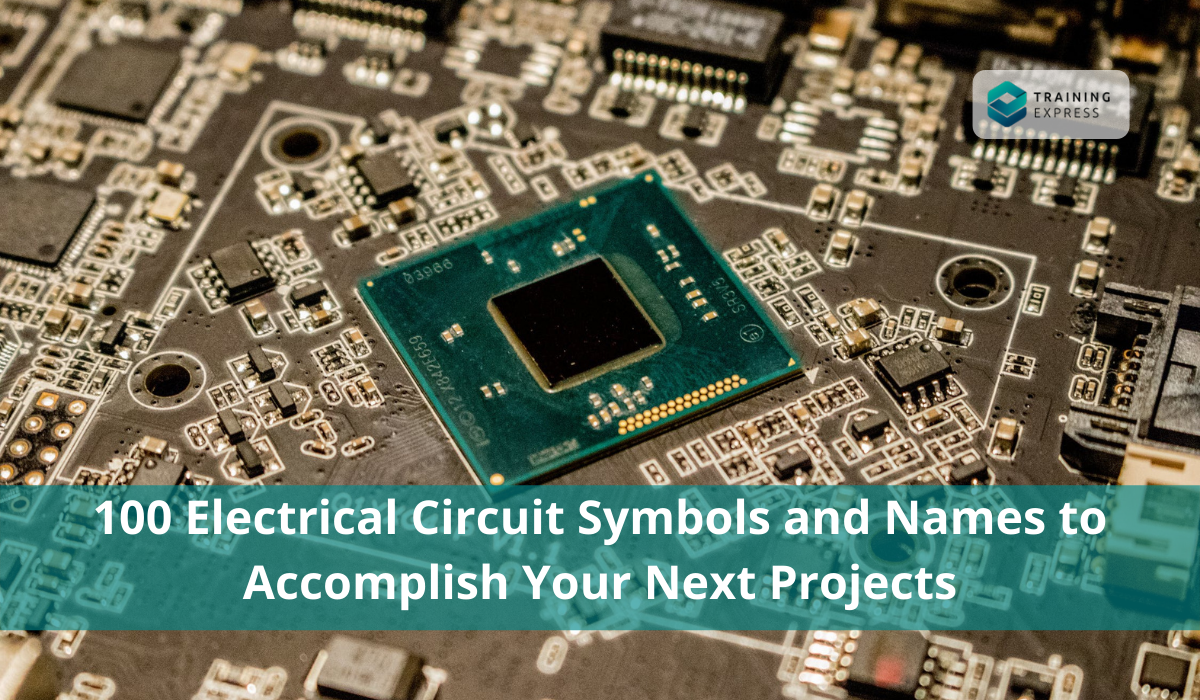

Would human lives be the same without electricity and electronics? We all know the answer to that. This is one of the most critical and recognized branches of modern engineering. The mesh functions of wires, switches, sources, and grounds all work together incredibly. That ensures a seamless and uninterrupted flow of electric currents. Do you already have a grasp of basic electronics? Then you already know the critical role of circuit symbols and names.
Circuit symbols and names are small images that represent an electrical or electronic device or function. Circuit symbols and names are used for creating diagrams. And these diagrams show how a circuit is connected. They are essential in designing circuits or making printed circuit boards for a project.
If you’re working on coding for such projects and need guidance, programming homework help can provide the support necessary to navigate complex circuit simulations and ensure your software matches your schematic designs.
Below, we will describe 100 critical electrical and electronic circuit symbols and names for your reference. They are crucial to creating appropriate circuit designs. Furthermore, they can showcase information on the wirings, locations of the equipment, layout, and details. Finally, it will be convenient for you to arrange these components in the future if done correctly.
1. Circuit Symbols and Names for Wires:
Wires are the components that allow current to pass quickly from one part of the circuit to another. They can be characterized as single and made with flexible materials. They will enable you to connect power supplies to the printed circuit board (PCB) and between the components. The wires are classified into various types that are discussed below.
| Components | Circuit symbol | Function |
| Wires | The very basic version of the wire, allowing the current to pass from one component to another. | |
| Joined wires | The wires can be connected, and the connection can be defined as ‘joined wires.’ The joining points of the wires are called ‘blob.’ The blob might sometimes be omitted in some circuit designs. | |
| Disjointed wires | In complex diagrams, it is often necessary to draw wires crossing even though they aren’t connected. In this case, bridging is commonly utilized – as pictured in the circuit symbol. | |
| Input bus line | The input bus line represents a bus for input or incoming data. | |
| Output bus line | The output bus line represents a bus for output or outgoing data. | |
| Terminal | The terminal represents the start or endpoint. | |
| Bus line | The bus line represents several conductors joined together to form a bus wire. |
2. Circuit Symbols and Names for Switches:
Simply, a switch is an electronic component that will allow you to connect the circuits according to your wish. If the switch is closed, then that will enable the circuits to be connected. However, if it is open, then it will break the connection, resulting in disconnected circuits. Below are the circuit symbols and names of different types of switches.
| Components | Circuit symbol | Function |
| Push switch | The push switch allows the current to flow only when the button is pushed. Thus, the function mimics the operation of a doorbell. | |
| Push-to-break switch | Normally, the push-to-break switch is closed (on); it will open (off) when the button is pushed. | |
| On-off switch (SPST) | SPST means Single Pole, Single Throw. The on-off switch will allow you to ensure that the current flows only when it is in the closed position. | |
| 2-way switch (SPDT) | SPDT means Single Pole, Double Throw. It is a 2-way changeover switch that allows conducting the flow of current to one of two routes. | |
| Dual on-off switch (DPST) | DPST means Double Pole, Single Throw. It is a dual on-off switch, and it can isolate both the live and neutral connections. Mainly used for electrical lines. | |
| Reversing switch (DPDT) | DPDT means Double Pole, Double Throw. It can be rewired up as a reversing switch, which is helpful in a motor. | |
| Relay | Usually found hidden in devices, it is a simple electrically operated switch. They are made with an electromagnet and a set of contacts. |
3. Circuit Symbols and Names for Power Supplies:
A Power supply or (a power supply unit) functions to supply electrical energy to the load and a device by definition. Watts is the measuring unit for the flow of electrical current. It serves to transform the energy from one form to another according to our requirements. The power supplies are classified into various types. Have a look at the chart below for the circuit symbols and names for those types.
| Components | Circuit symbol | Function |
| Cell | The cell is defined to supply electrical energy. The positive (+) one is the more significant terminal on the left. | |
| Battery | The battery is defined as the collection of more than one cell to supplying electrical energy. The positive (+) one is the bigger terminal on the left. | |
| DC supply | DC means Direct Current, which denotes constantly flowing in one direction. It supplies electrical energy. | |
| AC supply | AC means Alternating Current, which denotes current continually changing directions. It supplies electrical energy. | |
| Constant Current Source | The symbol showcases an independent current source that delivers constant current. | |
| Controlled Current Source | This symbol showcases a dependent current source. It usually depends on other sources (voltage or current). | |
| Controlled Voltage Source | This symbol showcases a dependent voltage source. It usually depends on other sources (voltage or current). | |
| Fuse | Fuse functions as a safety device that either blows or melts if the current flowing through it exceeds a specific value. | |
| Transformer | The transformer is two coils of wire connected to an iron core. They can be used to increase or decrease AC voltage. While there is no connection between the coils, the magnetic field in between the coils allows the energy to be transferred between them. | |
| Earth | The symbol denotes a connection to the earth. Also known as the ‘ground.’ For electrical circuits, this defines 0V (zero volts) of the power supply. | |
| Signal ground | Signal ground defines a reference point from which the signal is measured. Due to the voltage drops in a circuit, there may be several signal grounds in a circuit | |
| Chassis Ground | The chassis ground acts as a barrier between the user and the circuit. It also prevents electric shock. |
4. Circuit Symbols and Names for Resistors:
A resistor is a two-terminal element. Functionally, it radiates energy in the form of heat. And at the same time, it works to oppose the current flow in a circuit. An overflow of current through a resistor damages it. Ohms is the unit of the resistance value. There is a device for calculating the value of the resistors. The name resistor colour code calculator knows it. The resistors are classified into various types that are discussed below.
| Components | Circuit symbol | Function |
| Resistor | A resistor stops or obstructs the flow of current. | |
| Rheostat | A rheostat is a type of variable resistor usually used to control current. Examples: lamp brightness adjuster, motor speed adjuster. | |
| Potentiometer | A potentiometer is a type of variable resistor with three contacts. It is used to control voltage. | |
| Preset | A preset is a type of variable resistor. It is operated with a tool similar to a small screwdriver and designed to be set at the time of the creation of the circuit. Presets are usually left without further adjustments and used to reduce project costs. That’s because Presets are cheaper than variable resistors. | |
| Varistor | The varistor is short for a Voltage Dependent Resistor. Its characters align with non-linear current-voltage. They are generally used in circuit protection from voltage surges. | |
| Magneto Resistor | Also known as Magnetic Dependent Resistors (MDR). Their resistance varies according to the external magnetic field strength. | |
| Tapped resistor | The tapped resistor is a wire-wound type fixed resistor with one or more terminals along its length. They are generally used in voltage divider applications. | |
| Attenuator | To lower the power of a signal, attenuators are heavily favoured. As they are made from simple voltage dividers, they are usually defined within the family of resistors. | |
| Memristor | Memristor’s resistance changes according to the direction of flow of charge. |
5. Circuit Symbols and Names for Capacitors:
Just like a resistor, a capacitor is also a two-terminal passive component. But it has the capacity of storing electrical energy and is generally defined to be a condenser. They act like rechargeable batteries used in power supplies. They act like a filter that allows only AC current and blocks DC current. They are classified into various types that are discussed below.
| Components | Circuit symbol | Function |
| Capacitor | As mentioned above, it is used to store energy in electrical form. | |
| Polarised capacitor | A type of capacitor that stores electrical energy that must be a one-way round. | |
| Variable capacitor | A type of capacitor is used to control the level of the capacity by adjusting the Knob. | |
| Trimmer capacitor | A type of capacitor is used to control the capacity level by using a screwdriver or similar tools. |
6. Circuit Symbols and Names for Diodes:
The diode contains two terminals, defined to be anode and cathode. The diode is controlling the electron current flow from cathode to anode. Functionally, the diode has low resistance in one direction and high resistance in another direction. They are classified into various types that are discussed below.
| Components | Circuit symbol | Function |
| Diode | The component that allows current to flow in one direction only. | |
| Light Emitting Diode | A type of diode that converts electrical energy to light. | |
| Zener Diode | A type of diode that is used to conserve a secure voltage across its terminals. | |
| Photo Diode | A type of diode that converts light into respective current or voltage. | |
| Tunnel Diode | A type of diode used for very high-speed operations. | |
| Schottky Diode | A type of diode used for forwarding low voltage drop. | |
| Varactor Diode | A type of diode that can change the level of the capacitance according to the input voltage applied. Also known as ‘Varicap’. | |
| Shockley Diode | A type of diode that has a fast switching operation and hence is used in switching applications. | |
| Thyristor | A type of diode that acts as bistable switches and is used in circuits where high voltages and currents are involved. | |
| Constant Current Diode | A type of diode that limits the current to a specified maximum value. Also known as Current Limiting Diode or Current Regulating Diode. | |
| Laser Diode | A type of diode that is similar to LED. Its applications are found in laser printing, laser scanning, etc. |
7. Circuit Symbols and Names for Transistors:
Considered to be a scientific breakthrough, transistors play an essential role in all modern electronics. It contributed by replacing vacuum tubes, which control the flow of current and voltage in the circuits. It is a semiconductor device that is used to amplify or switch electronic signals and electrical power. They are classified into various types that are discussed below.
| Components | Circuit symbol | Function |
| NPN transistor | A type of transistor where a P-type doped semiconductor material is placed in between two N-type semiconductor materials. | |
| PNP transistor | A type of transistor where an N-type doped semiconductor material is placed in between two P-type semiconductor materials. | |
| Phototransistor | A type of transistor that converts light to current. | |
| Field Effect Transistor | A type of transistor that controls the conductivity with the help of an electric field. | |
| N-channel JFET | JFET means Junction Field Effect Transistors are simple of FET for switching | |
| P-channel JFET | JFET means Junction Field Effect Transistors where a P-type semiconductor is placed in between N-type junctions. | |
| Enhancement MOSFET | MOSFET means metal–oxide–semiconductor field-effect transistor. Similar to MOSFET but it does not contain a conducting channel. | |
| Depletion MOSFET | In depletion MOSFET, the current flows from source to drain terminal. | |
| Photo Darlington | This transistor is similar to a photo transistor, but its core feature is very high gain and sensitive. |
8. Circuit Symbols and Names for Meters:
The Meter is a device that helps by measuring voltage and current flow in electrical and electronic components. The circuit symbols and names of various types of Meters are discussed below.
| Components | Circuit symbol | Function |
| Voltmeter | A type of meter that is used to measure voltage. | |
| Ammeter | A type of meter that is used to measure current. | |
| Galvanometer | A type of sensitive meter that is used to measure tiny currents, usually 1mA or less. | |
| Ohmmeter | A type of meter is used to measure resistance. | |
| Oscilloscope | A type of meter is used to display the shape of electrical signals. Also, it can be used to measure their voltage and time period. |
9. Circuit Symbols and Names for Audio Devices:
Audio devices transform electric signals into sound signals. It can also do the opposite. They serve as input/output electronic components in the circuit diagram. The circuit symbols and names for various types of Audio Devices are discussed below.
| Components | Circuit symbol | Function |
| Microphone | A type of audio device that converts a sound or noise signal to an electrical signal. | |
| Earphone | A type of audio device that converts an electrical signal to a sound signal. | |
| Loudspeaker | A type of audio device that converts the electrical signal to sound signal, but it will amplify the version. | |
| Piezo- transducer | A type of audio device that converts the flow of electrical energy to a sound signal. | |
| Bell | A type of audio device that converts the electrical signal to a sound signal. | |
| Buzzer | A type of audio device that converts an electrical signal to a sound signal. |
10. Circuit Symbols and Names for Sensors (Input devices):
Sensors are wired to spot or sense moving objects and devices. When it receives the signal, it converts them into electrical or optical signals. They are classified into various types that are discussed below.
| Components | Circuit symbol | Function |
| LDR | LDR means Light Dependent Resistor. It is a type of sensor which converts light to resistance, an electrical property. | |
| Thermistor | The thermistor is a type of sensor which converts temperature (heat) to resistance, an electrical property. |
11. Circuit Symbols and Names for Wave Generators:
Wave generators are a type of electronic equipment that is used to generate electrical waveforms. They can be either repetitive or single-shot, but in those cases, either some internal or external trigger source is required. These waves can be analysed across a timeline. They are classified into various types that are discussed below.
| Components | Circuit symbol | Function |
| Sinusoidal generator | The sinusoidal generator represents a sine wave generator. | |
| Pulse generator | The pulse generator represents a pulse or square wave generator. | |
| Triangular wave | The triangular wave represents a triangular wave generator. |
12. Circuit Symbols and Names for Inductors:
The inductors are passive two-terminal electrical components. When electric current flows through the terminals, it stores energy in a magnetic field. Also, an insulated wire wound is a key feature of an inductor. They are classified into various types that are discussed below.
| Components | Circuit symbol | Function |
| Iron Core Inductor | The iron core has an air gap integrated with it. This allows for a lower permeability than ferrite core inductors. | |
| Ferrite Core Inductors | Ferrite core inductors have ferrite core material as their key ingredient. These inductors are used to suppress the interference of electromagnetic waves. | |
| Center Tapped Inductors | Center tapped inductors are used in the coupling of signals. | |
| Variable Inductors | The variable inductors can vary the induction level by sliding the core in or out of the coil. |
13. Circuit Symbols and Names for Amplifiers:
An amplifier is a device that takes a small input signal and can increase the power or amplify the signal. They are classified into various types that are discussed below.
| Components | Circuit symbol | Function |
| Basic Amplifier | As mentioned above, the basic amplifier can amplify a relatively small input signal, i.e., it increases the power of the signal. | |
| Operational Amplifier | The operational amplifier is similar to the basic amplifier but with a high gain. The input is differential here. |
14. Circuit Symbols and Names for Antenna:
The antenna is a device that converts electrical power into radio waves. Antennas are primarily used in wireless communication. The device is potent to transmit or receive the signals.
| Components | Circuit symbol | Function |
| Antenna | The definition of the antenna is available above. The symbol depicts an Aerial or Antenna. | |
| Loop Antenna | As its name suggests, the loop antenna contains a loop-like shape of wire or other electrical conductors. They are particularly useful in receiving signals in the low-frequency range. | |
| Dipole Antenna | One of the most widely used antennas. It is primarily applicable for set-top boxes, FM radio, and shortwave transmissions. |
15. Circuit Symbols and Names for Logic Gates:
Logic gates are defined to be the main building blocks in digital circuits. Usually, the logic gates will have two or three inputs and a single output. Based on a certain logic, the outputs get produced. If we observe their truth tables, it will showcase the basic Logic gate values represented in binary.
| Components | Circuit symbol | Function |
| NOT gate | For the NOT gate, The output is the complement of the input. | |
| AND gate | For the AND gate, the output value is HIGH when two inputs are HIGH. | |
| NAND gate | The NAND gate is a complement of the AND gate. | |
| OR gate | For the OR gate, the output value is HIGH when one of the inputs is HIGH. | |
| NOR gate | OR gate is a complement of the NOR gate. | |
| EX-OR gate | For the EX-OR gate, the output is HIGH when an odd number of HIGH occurs in its inputs. | |
| EX-NOR gate | For the EX-NOR gate, the output is HIGH when an even number of HIGH occurs in its inputs. |
16. Circuit Symbols and Names for Miscellaneous Components:
| Components | Circuit symbol | Function |
| Buzzer | Functions to produce a buzzing sound when the voltage is applied. | |
| Loud Speaker | Functions to emit a sound signal which got converted from an electrical signal. | |
| Light Bulb | Functions by emitting light when required voltage is applied. | |
| Motor | Functions by converting the electric energy to mechanical energy. | |
| Fuse | Functions as a protection for the circuit against the over-flowing current. | |
| Crystal Oscillator | Functions by generating clock signals of precise frequency. | |
| ADC | ADC means Analogue to Digital converter. It functions by converting analogue signals to digital values. | |
| DAC | DAC means Digital to Analogue converter. It functions by converting digital codes to analogue signals. | |
| Thermocouple | Functions as a device to measure temperature. |
Closing Note
So here you have your 100 Electrical and Electronic Circuit symbols and names! They indeed can be challenging in the beginning to master. And you don’t even have to learn and understand everything right away. But getting starting is the important part here. Are Circuit symbols and names still daunting for you? Then you can check how our friendly experts and trainers can help you in this beginner’s course.
- Available Courses
- Healthcare167
- Mandatory Training36
- Administration & Office Skills2
- HR & Leadership2
- Charity & Non-Profit Courses28
- Job Ready Programme39
- Animal care10
- Law9
- Quality Licence Scheme Endorsed112
- Teaching17
- Teaching & Academics Primary31
- Accounting & Finance Primary40
- Training6
- Design26
- IT & Software205
- Health and Safety482
- Marketing35
- Career Bundles172
- Construction53
- Electronics30
- Hospitality26
- Health and Social Care285
- Child Psychology40
- Management396
- Business Skills287
- First Aid73
- Employability278
- Safeguarding75
- Food Hygiene107
- Personal Development1464
 Food Hygiene
Food Hygiene Health & Safety
Health & Safety Safeguarding
Safeguarding First Aid
First Aid Business Skills
Business Skills Personal Development
Personal Development






